Medication Comparison Tool
Compare Endep (Amitriptyline) with its alternatives based on key factors.
When a doctor prescribes Endep (Amitriptyline) you’re getting a classic tricyclic antidepressant (TCA) that’s been around since the 1960s. It works for depression, chronic nerve pain, and even migraine prevention, but it’s not the only player in the field. If you’ve heard about newer drugs, wonder about side‑effects, or need a different option for a specific condition, this guide breaks down Endep and the most common alternatives so you can see which one fits your needs.
TL;DR
- Endep is a TCA effective for depression, neuropathic pain, and migraine prophylaxis but can cause sedation, weight gain, and cardiac effects.
- SSRIs (e.g., sertraline, escitalopram) are first‑line for depression with fewer anticholinergic side‑effects.
- SNRIs (e.g., venlafaxine, duloxetine) treat both mood and pain, offering a middle ground.
- Mirtazapine helps with depression + insomnia, but can increase appetite.
- Nortriptyline is a TCA with a cleaner side‑effect profile than Amitriptyline, often chosen for pain.
What Is Endep (Amitriptyline)?
Amitriptyline belongs to the tricyclic antidepressant class. Chemically it’s a dibenzazepine that blocks the reuptake of serotonin and norepinephrine, boosting their levels in the brain. The brand name Endep is commonly used in Australia and the UK. Typical doses start at 25mg nightly for sleep or pain and may be titrated up to 150mg for depression.
Because it also blocks histamineH1 receptors and muscarinic acetylcholine receptors, you’ll often feel drowsy or notice dry mouth-classic anticholinergic signs. Its half‑life ranges from 10 to 28hours, meaning steady‑state levels take about a week to settle.
How Does Amitriptyline Work?
The drug’s primary mechanism is inhibition of the serotonin transporter (SERT) and norepinephrine transporter (NET). This dual action raises neurotransmitter concentrations, which improves mood and modulates pain signals. Additionally, its antihistamine effect contributes to the sleep‑inducing quality many patients appreciate.
Metabolism occurs mainly through the liver enzyme CYP2D6. People who are poor metabolizers may experience higher blood levels, increasing the risk of side‑effects. Genetic testing can be useful when dosing feels unpredictable.
Common Alternatives to Endep
When clinicians talk about “alternatives,” they usually refer to three broad families: selective serotonin reuptake inhibitors (SSRIs), serotonin‑norepinephrine reuptake inhibitors (SNRIs), and newer atypical agents. Below is a quick snapshot of each class.
SSRIs - The First‑Line Choice for Depression
Selective serotonin reuptake inhibitors increase only serotonin levels. Popular options include Sertraline, Escitalopram, and Fluoxetine. They tend to have fewer anticholinergic effects, making them gentler on the heart and eyes.
Typical starting doses are 50mg for sertraline and 10mg for escitalopram, with maximums that rarely exceed 200mg. Side‑effects often include mild nausea, sexual dysfunction, and occasional insomnia-but rarely the heavy sedation seen with TCAs.
SNRIs - Mood Plus Pain Relief
Serotonin‑norepinephrine reuptake inhibitors, such as Venlafaxine and Duloxetine, block both SERT and NET, similar to Amitriptyline, but without the strong antihistamine and anticholinergic activity.
These drugs are often chosen for patients with concurrent depression and chronic pain (fibromyalgia, diabetic neuropathy). Starting doses are usually 37.5mg (duloxetine) or 75mg (venlafaxine) daily, and they have a more favorable weight profile than TCAs.
Mirtazapine - The Sleep‑Friendly Antidepressant
Mirtazapine works by antagonizing central alpha‑2 adrenergic receptors, which indirectly boosts norepinephrine and serotonin. It also blocks H1 receptors, giving a pronounced sedative effect useful for patients with insomnia.
It’s started at 15mg in the evening; common side‑effects are increased appetite and weight gain. Because it doesn’t inhibit CYP2D6, drug‑interaction risk is lower than with Amitriptyline.
Nortriptyline - A ‘Cleaner’ TCA
Nortriptyline is the primary active metabolite of Amitriptyline, but it lacks the strong antihistamine block. This translates to less drowsiness and fewer dry‑mouth complaints while retaining mood‑lifting and analgesic properties.
Doses range from 25mg to 100mg nightly. It’s often the go‑to TCA when a patient needs the TCA effect but can’t tolerate Amitriptyline’s side‑effect burden.
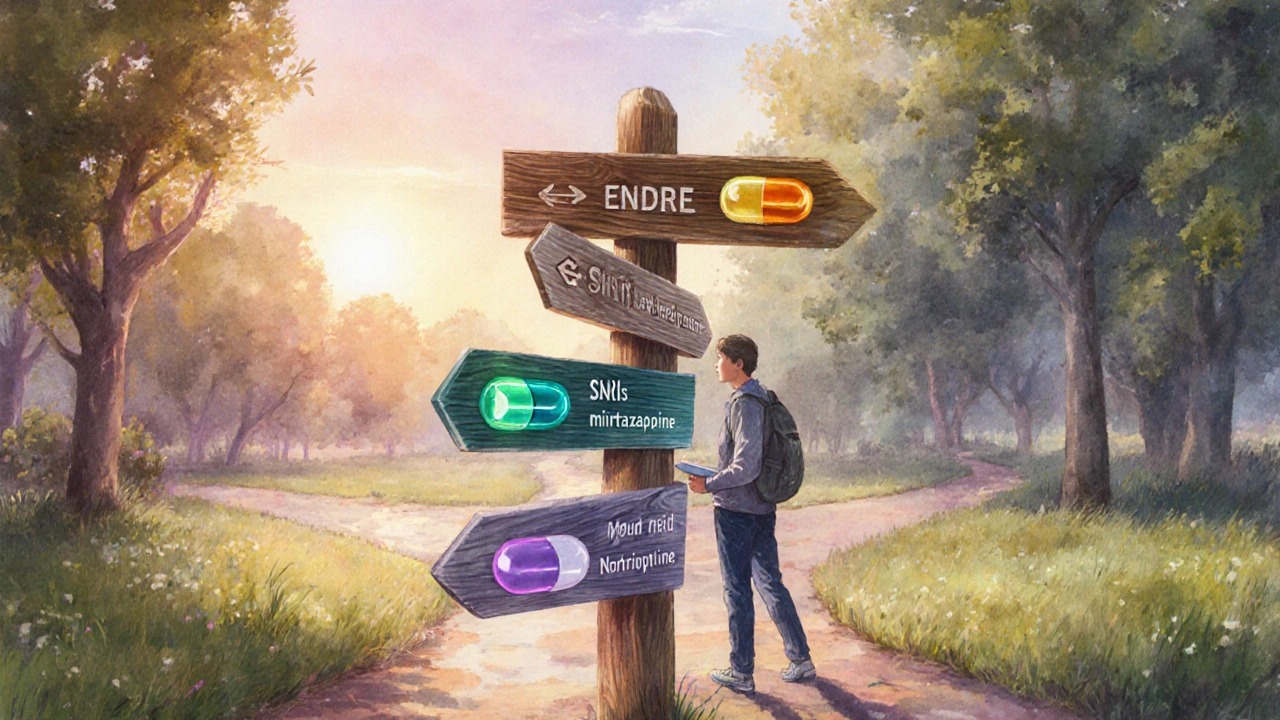
Side‑Effect Comparison at a Glance
| Attribute | Endep (Amitriptyline) | SSRIs (e.g., Sertraline) | SNRIs (e.g., Duloxetine) | Mirtazapine | Nortriptyline |
|---|---|---|---|---|---|
| Primary Indications | Depression, neuropathic pain, migraine prophylaxis | Depression, anxiety | Depression, chronic pain, fibromyalgia | Depression with insomnia | Depression, neuropathic pain |
| Mechanism | Dual SERT/NET inhibition + strong antihistamine & anticholinergic | Selective SERT inhibition | SERT & NET inhibition, mild antihistamine | Alpha‑2 antagonism, H1 blockade | SERT/NET inhibition, weaker antihistamine |
| Typical Starting Dose | 25mg nightly | 50mg daily (Sertraline) | 30mg daily (Duloxetine) | 15mg nightly | 25mg nightly |
| Common Side‑Effects | Dry mouth, constipation, weight gain, drowsiness, cardiac conduction delay | Nausea, sexual dysfunction, insomnia | Elevated blood pressure, nausea, sexual dysfunction | Increased appetite, weight gain, sedation | Dry mouth (less), mild sedation |
| Drug‑Interaction Risk | High (CYP2D6 substrate) | Moderate (CYP3A4, CYP2C19) | Moderate (CYP1A2, CYP2D6) | Low (minimal CYP involvement) | Moderate (CYP2D6) |
| Cardiac Safety | Can prolong QT, caution in heart disease | Generally safe | Generally safe | Safe | Better than Amitriptyline but still monitor |
Choosing the Right Option - Factors to Weigh
Every patient’s situation is different, so a systematic approach helps avoid guesswork.
- Underlying condition: If the primary goal is depression without pain, an SSRI often suffices. When pain is a major driver, SNRIs or TCAs shine.
- Side‑effect tolerance: Patients who can’t handle sedation, dry mouth, or weight gain may lean toward SSRIs or mirtazapine.
- Cardiac health: Anyone with arrhythmia, recent MI, or prolonged QT should avoid Amitriptyline and consider SSRIs or duloxetine.
- Drug‑interaction profile: Review current meds for CYP2D6 substrates (e.g., beta‑blockers, certain antipsychotics). If interactions are a concern, pick a drug with minimal CYP involvement.
- Age and metabolism: Elderly patients metabolize TCAs slower, raising toxicity risk. Lower starting doses and slower titration are key.
In practice, many clinicians start with an SSRI, assess response, and switch to an SNRI or TCA only if the mood‑pain combo isn’t adequately controlled.
Practical Tips & Common Pitfalls
Here are some real‑world nuggets you can apply right away.
- Start low, go slow: For Amitriptyline, 10mg nightly can already help with sleep. Increase by 10‑25mg every 1‑2 weeks based on response.
- Monitor blood pressure: SNRIs can raise systolic pressure; check monthly for the first three months.
- Watch for orthostatic hypotension: TCAs cause sudden drops when standing. Advise patients to rise slowly.
- Screen for suicidal thoughts: All antidepressants carry a black‑box warning for young adults. Conduct baseline PHQ‑9 and follow‑up regularly.
- Consider genetic testing: If the patient reports unusually strong side‑effects on Amitriptyline, a CYP2D6 test may explain poor metabolism.
- Address weight changes: Mirtazapine often causes weight gain; pair with lifestyle counseling if that’s a concern.
Bottom Line
If you’re looking for a versatile drug that tackles both mood and pain, Endep alternatives cover a range of mechanisms and side‑effect profiles. Amitriptyline remains a solid choice for patients who can tolerate its anticholinergic load and need strong analgesic action. For those prioritizing a cleaner side‑effect slate, SSRIs, SNRIs, or newer agents like mirtazapine are worth a look. The decision ultimately hinges on the specific symptom mix, medical history, and personal tolerance.
Frequently Asked Questions
Can I switch from Endep to an SSRI without a washout period?
Generally, no washout is needed because the half‑life of Amitriptyline is short enough to taper off over a week while starting the SSRI at a low dose. However, monitor for serotonin syndrome if the SSRI is introduced too quickly.
What makes Nortriptyline “cleaner” than Amitriptyline?
Nortriptyline lacks the strong antihistamine and anticholinergic activity that causes drowsiness and dry mouth. It still blocks serotonin and norepinephrine reuptake, so you keep the antidepressant and analgesic benefits with fewer sedative side‑effects.
Is Duloxetine better than Amitriptyline for diabetic neuropathy?
Clinical trials show Duloxetine provides comparable pain relief with a lower risk of cardiac conduction issues and less anticholinergic burden. It’s often preferred when patients have heart disease or are older.
Why do some patients feel more energized on SSRIs compared to TCAs?
SSRIs selectively boost serotonin without the heavier norepinephrine lift that TCAs provide. The lack of antihistamine effect also means less sedation, so patients often report a lighter, more awake feeling.
Can I take Amitriptyline for migraine prevention if I’m already on a beta‑blocker?
Yes, but check for additive sedation and blood pressure effects. Both drugs can lower blood pressure, so monitor vitals during the titration phase.



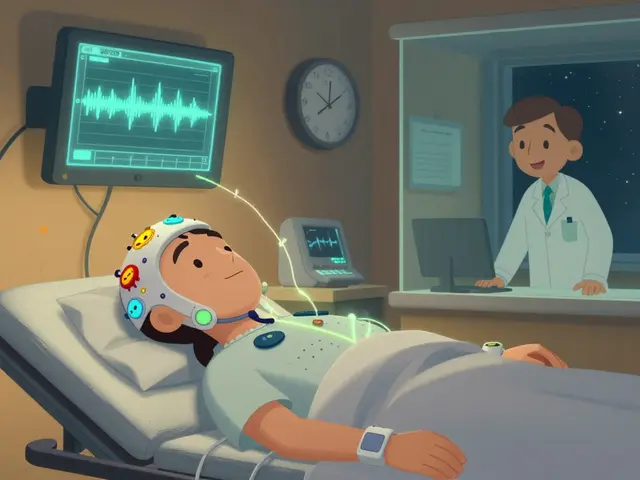

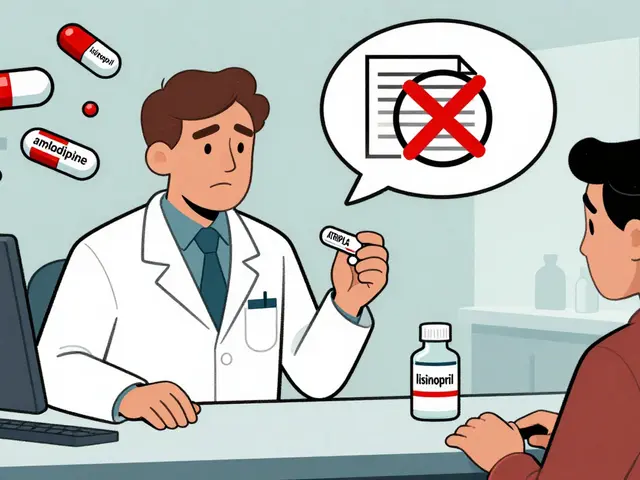
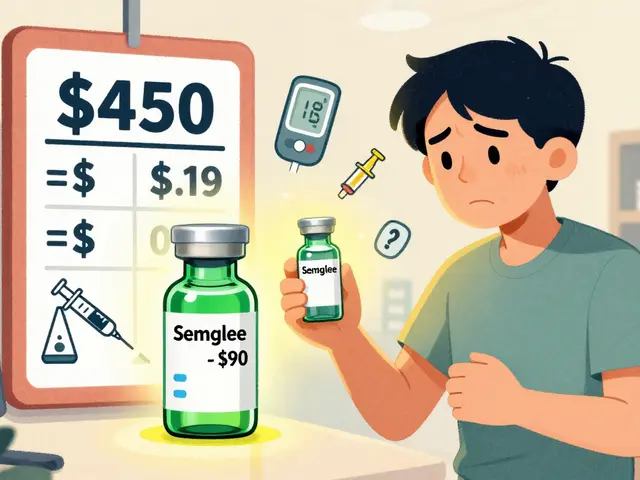
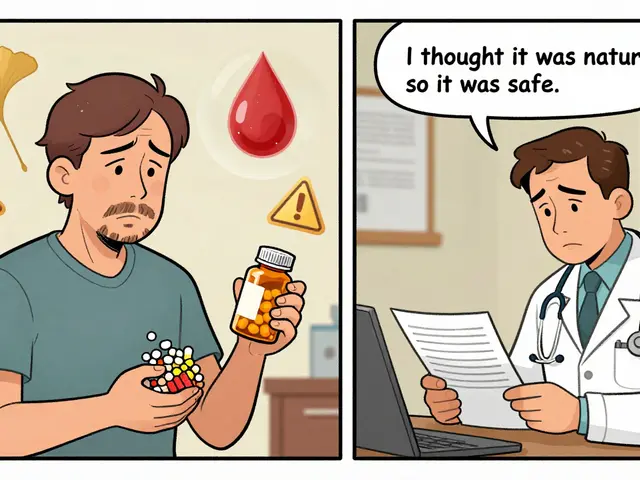


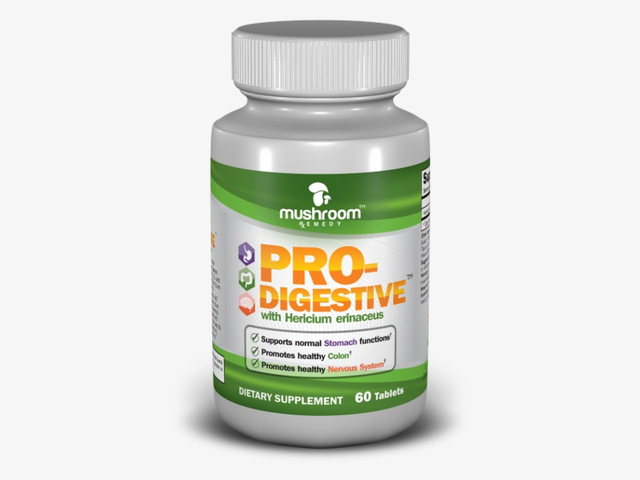


16 Comments
Wow, this is a rollercoaster of meds 😂
Reading through this guide feels like a roadmap for anyone tangled in the antidepressant maze!!! The breakdown of side‑effects is spot on, and the step‑by‑step dosage advice could save weeks of trial‑and‑error. Keep pushing forward, and remember that tweaking the dose is a marathon, not a sprint!!! 💪
The article nails the pharmacodynamics of Amitriptyline, yet it could clarify that “high side‑effect tolerance” actually implies a willingness to endure anticholinergic burden, not merely sedation. Also, the term “Migraine” should be capitalized consistently. Overall, solid content with minor copy‑editing tweaks.
Honestly, the table looks cleaner than the prose-just give us the chart and skip the fluff 😒
One must consider the ethical ramifications of prescribing a drug with such a formidable anticholinergic profile to vulnerable populations; it is incumbent upon clinicians to prioritize patient autonomy over pharmacological convenience.
While the exposition attempts an egalitarian tone, the underlying premise betrays a subtly elitist bias that some readers may find off‑putting; indeed, the author’s penchant for jargon appears to be a deliberate ploy to obfuscate rather than elucidate. Definately worth a second read.
Great, another exhaustive list of side‑effects-just what I needed before my coffee.
The comparative analysis presented herein affords a comprehensive overview of Amitriptyline’s pharmacological footprint relative to its contemporaries.
From a mechanistic standpoint, the dual inhibition of serotonin and norepinephrine reuptake confers both antidepressant and analgesic properties, a feature not ubiquitously shared among serotonergic agents.
However, the concomitant antagonism of histamine H1 and muscarinic receptors precipitates a constellation of anticholinergic adverse events that warrant meticulous titration.
Clinical pharmacokinetics reveal a half‑life extending beyond 24 hours, necessitating vigilance for accumulation in hepatic impairment.
Comparative efficacy data suggest that the tricyclic class retains superiority in neuropathic pain syndromes when contrasted with selective serotonin reuptake inhibitors.
Nonetheless, the risk–benefit calculus shifts dramatically in the presence of cardiac comorbidities, given the propensity of Amitriptyline to prolong QT intervals.
In such scenarios, serotonin‑norepinephrine reuptake inhibitors such as duloxetine emerge as viable alternatives with a more favorable cardiac safety profile.
The table of side‑effects cogently delineates the frequency of dry mouth, weight gain, and orthostatic hypotension, yet it omits a quantitative metric for patient‑reported quality‑of‑life outcomes.
Moreover, the discussion could benefit from integration of pharmacogenomic considerations, specifically CYP2D6 polymorphisms influencing plasma concentrations.
The editorial decision to juxtapose nortriptyline as a “cleaner” tricyclic is substantiated by its attenuated antihistaminic activity, albeit with retained therapeutic potency.
For clinicians navigating polypharmacy, the drug‑interaction matrix underscores Amitriptyline’s status as a high‑risk substrate for cytochrome P450 enzymes.
It is prudent to implement baseline ECG monitoring when initiating therapy in patients with a history of arrhythmia.
From a psychosocial perspective, the sedative attributes of Amitriptyline may be harnessed therapeutically for comorbid insomnia, provided the patient is counseled regarding daytime somnolence.
Ultimately, individualized treatment regimens should reconcile the biochemical mechanisms with patient preference, tolerability thresholds, and comorbid disease burden.
🧐 In sum, Amitriptyline remains a valuable agent within the antidepressant armamentarium, but its deployment must be judicious, evidence‑based, and patient‑centric.
Oh great another drug guide, just what I needed 🙄
The data tables provide a clear side‑effect hierarchy, facilitating quick clinical decisions.
Reading through this feels like stepping into a pharmacy labyrinth, each aisle lined with promises and pitfalls. The author paints Amitriptyline as a double‑edged sword-so potent yet so perilous. I can almost hear the thrum of the heart monitor as the cardiac warnings echo. Still, the hope that this knowledge empowers patients shines through the technical haze. Keep fighting the good fight, folks!
Thank you for the thorough comparison; it will be a valuable reference when discussing options with patients.
While the exposition is undeniably exhaustive, it could be streamlined by summarizing the pharmacogenomic nuances into a concise sidebar; clinicians often lack the time for a fifteen‑sentence deep dive.
Actually, the shortcut you propose would omit critical safety alerts-especially the ECG monitoring recommendation-and could mislead prescribers into under‑estimating cardiac risk.
That’s a good reminder to always weigh the moral side of prescribing, especially for those who might be more vulnerable.
Sure, but don’t forget that many clinicians still default to the oldest guidelines, regardless of newer comparative data.